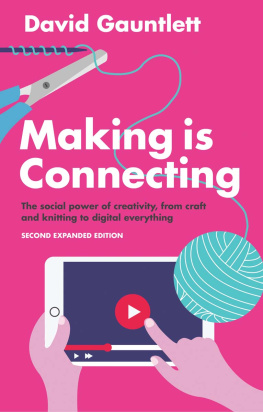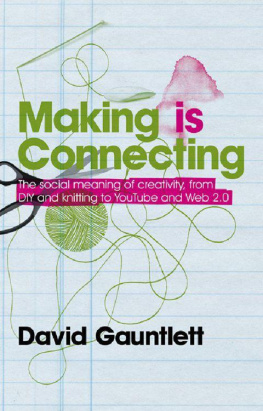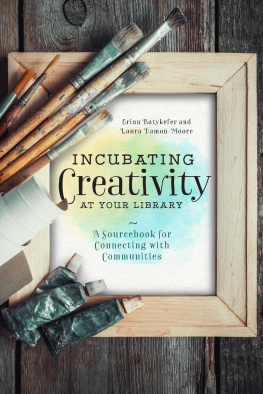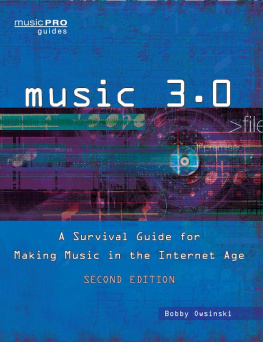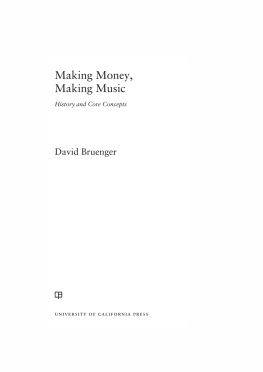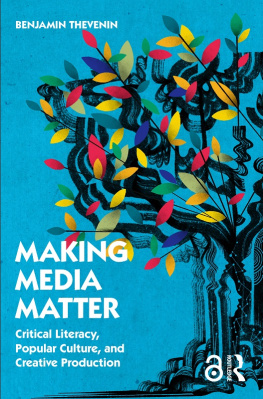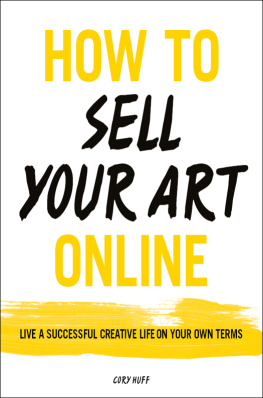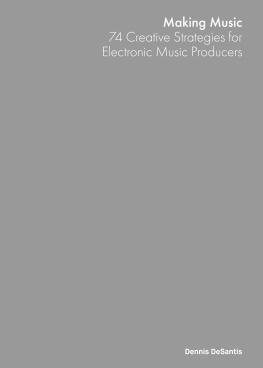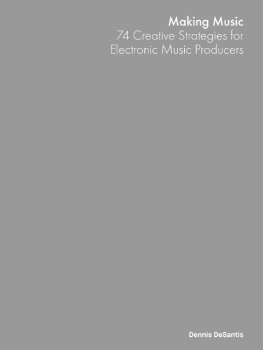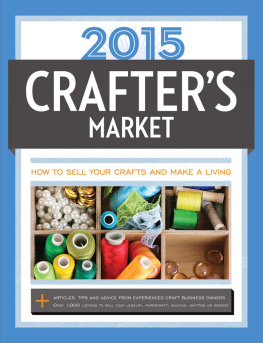Contents
Guide
Pages

For Finn
MAKING IS CONNECTING
The social power of creativity, from craft and knitting to digital everything
Second expanded edition
DAVID GAUNTLETT
polity
Copyright David Gauntlett 2018
The right of David Gauntlett to be identified as Author of this Work has been asserted in accordance with the UK Copyright, Designs and Patents Act 1988.
First edition published in 2011 by Polity Press
This second edition published in 2018 by Polity Press
Polity Press
65 Bridge Street
Cambridge CB2 1UR, UK
Polity Press
101 Station Landing
Suite 300
Medford, MA 02155, USA
All rights reserved. Except for the quotation of short passages for the purpose of criticism and review, no part of this publication may be reproduced, stored in a retrieval system or transmitted, in any form or by any means, electronic, mechanical, photocopying, recording or otherwise, without the prior permission of the publisher.
ISBN-13: 978-1-5095-1351-2
A catalogue record for this book is available from the British Library.
Library of Congress Cataloging-in-Publication Data
Names: Gauntlett, David, author.
Title: Making is connecting : the social power of creativity, from craft and knitting to digital everything / David Gauntlett.
Description: Second edition. | Medford, MA : Polity, 2018. | Revised edition of the authors Making is connecting, 2011. | Includes bibliographical references and index.
Identifiers: LCCN 2017043969 (print) | LCCN 2017052215 (ebook) | ISBN 9781509513512 (Epub) | ISBN 9781509513475 (hardback) | ISBN 9781509513482 (paperback)
Subjects: LCSH: Social networks. | Creative ability--Social aspects. | Web 2.0--Social aspects. | Culture. | BISAC: SOCIAL SCIENCE / Media Studies.
Classification: LCC HM741 (ebook) | LCC HM741 .G38 2018 (print) | DDC 302.30285--dc23
LC record available at https://lccn.loc.gov/2017043969
The publisher has used its best endeavours to ensure that the URLs for external websites referred to in this book are correct and active at the time of going to press. However, the publisher has no responsibility for the websites and can make no guarantee that a site will remain live or that the content is or will remain appropriate.
Every effort has been made to trace all copyright holders, but if any have been inadvertently overlooked the publisher will be pleased to include any necessary credits in any subsequent reprint or edition.
For further information on Polity, visit our website: www.politybooks.com
ACKNOWLEDGEMENTS
For the first edition of this book, I acknowledged the help and support of many fine individuals. Here I have ungraciously clumped the key people into this one paragraph and sorted them into alphabetical order. Sorry. But, genuinely, many thanks to: Edith Ackermann, David Brake, Tessy Britton, Nick Couldry, Andrea Drugan, Andrew Dubber, Jenny Gauntlett, Pete Goodwin, David Hendy, Annette Hill, Dougald Hine, David Jennings, Jesper Just Jensen, Anastasia Kavada, Knut Lundby, Anthony McNicholas, Alison Powell, Tim Riley, Amanda Blake Soule, Jeanette Steemers, Paul Sweetman, Anna-Sophie Trolle Terkelsen, Cecilia Weckstrm, David Whitebread and Thomas Wolbers.
I am also grateful to Tiziano Bonini, who did a very nice translation of the book into Italian (La Societ dei Makers), and the nameless employees of Samcheolli Publishing in Seoul, who made a neat Korean version with bonus pictures.
For this second edition, I would like to give many thanks to again in alphabetical order Fauzia Ahmad, Pete Astor, Jen Ballie, Mary Kay Culpepper, Susie Farrell, Christian Fuchs, Matt Gooderson, Roland Harwood, Kirsten Hermes, Heidi Herzogenrath-Amelung, Velislava Hillman, Julia Keyte, I-Ching Liao, Simon Lindgren, Sunil Manghani, Winston Mano, Graham Meikle, Kirstin Mey, David Pallash, Mike Press, Mitch Resnick, Isabelle Risner, David Sheppard, Katie Smith, Tina Holm Sorensen, Jonathan Stockdale, Bo Stjerne Thomsen, Clare Twomey and Cecilia Weckstrm.
Many thanks to Mary Savigar, Ellen MacDonald-Kramer and Elen Griffiths at Polity for being such supportive editors, and I am grateful to Breffni OConnor, Clare Ansell, Jane Fricker and Leigh Mueller on the production and marketing side.
I should also thank all the sharp, diverse and witty students who helped to refine some of these thoughts by participating in my Creativity module at the University of Westminster in the years since 2010.
In the first edition, I was pleased to acknowledge the UKs Arts and Humanities Research Council (AHRC), and the Research Councils UK Digital Economy programme, for research awards which as I said then although not specifically supporting this project, did fund related work and gave me time to think about these things. Those included projects with the reference numbers AH/H038736/1, AH/F009682/1, AH/F006756/1 and EP/H032568/1. For work conducted between the first and second editions, I acknowledge the support of the Digital DIY project, funded by the EU Horizon 2020 Research and Innovation Framework Programme (Grant agreement 644344); Digital Folk, funded by the AHRC (AH/L014858/1); Advancing Social Media Studies, funded by STINT in Sweden; and Community-powered Transformations, funded by the AHRC (AH/J01303X/1).
As ever, huge love to Finn and Edie for supporting and inspiring me every day. And last but most, all my love and gratitude to Jenny for being such a thoughtful and creative partner in ideas and life and everything.
As always, the responsibility for any weird arguments, spurious sentimentality and unreasonable optimism that you may find here remains my own.
PREAMBLE TO THE SECOND EDITION
Hello, and welcome, or welcome back, to Making is Connecting. This tries to be a fundamentally positive book about a fundamentally positive thing the power of making. Everyday creativity can give us a sense of potency, expressive ways to connect with other people, and a sense of meaningful engagement with the world. This has been true for many thousands of years, but has been boosted and amplified in recent times by the emergence of accessible networked technologies that enable us to connect, exchange things, and inspire each other.
The first edition of this book was written in 200910, and came out in 2011. Here I greet you at the start of the second edition, which I revised and wrote in 201617, to come out in 2018. Making is connecting is a timeless proposition, and should be a pretty time-proof book, but, you know, things happen, and the context changes even when the essence of creativity remains the same. So there are some things we need to deal with here.
NEW GLOOM
Frankly, when we think about the digitally-connected world, things do seem rather less bright and shiny than before. There are three striking and depressing elements, and each is huge. First, governments around the world turned out to be much more committed to 1984-style mass surveillance recording everyones online interactions than ever seemed either possible or likely. It was in 2013 that Edward Snowden bravely exposed the unexpectedly vast level of monitoring and storage of personal communications in the US, and by implication or explicit extension everywhere else. A few years on, this fundamental lack of personal privacy seems to be more-or-less accepted as normal.
Second, the corporations running online platforms were revealed as ruthless monopolies that suck vast amounts of money out of the creative ecosystem, while contributing nothing other than services to advertisers. Of course, it was well known that record companies and publishers in the twentieth century were ungenerous to artists, but new modes of distribution especially for music have counterintuitively decimated the opportunities for the majority of artists to make a living. (Jonathan Taplins 2017 book

